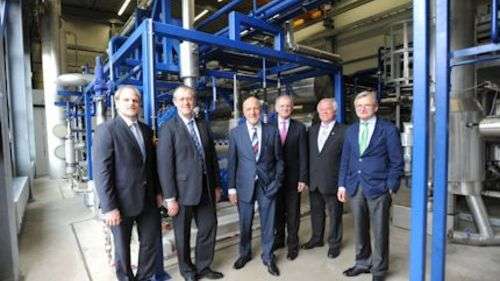New Carbon dioxide production plant at Industriepark Höchst conserves resources and lowers emissions
The facility is located on a 1,300 square meter lot owned by Infraserv GmbH & Co. Höchst KG, the site operator. The raw material used in production is CO2, which is generated by neighboring Celanese Chemicals Europe GmbH as a byproduct of vinyl acetate production. "We recycle and upgrade a waste product, and then make sure it is reused," said Heinz Gausling, Project Manager at Westfalen AG. Celanese benefits from the arrangement, too: "Our vinyl acetate production plant at Industriepark Höchst is one of the largest of its kind. By integrating vinyl acetate production with the new carbon dioxide plant, we cannot only reduce our CO2 emissions tremendously, but also enable this waste product to be transformed into a valuable commodity," emphasized Arno Rockmann, Site Director of Celanese Frankfurt and Chief Technology Officer of Celanese Chemicals Europe GmbH.
For Roland Mohr, Managing Director at site operator Infraserv Höchst, the project underscores the benefits offered by Industriepark Höchst, where around 90 companies form a highly diverse research and production network. "Innovative projects that deliver significant environmental benefits are best implemented at large industrial estates where efficient resource management is part of the day-to-day business," said Mohr.
Westfalen AG designed and constructed the plant. A roughly 200 meter pipeline transports the untreated gas from the Celanese facility to the new plant. In the machinery building, it passes through a purification and liquefying system. Next, the CO2, now cooled down to -25 °C, is pumped to three high-level tanks outside. Each tank can hold 100 tons of liquefied CO2. A tank truck loading point located right in front of the tanks allows authorized drivers to independently fill up with CO2 for transportation to major customers or to gas producers' plants and depots. The plant generally runs autonomously. It is controlled and monitored by the Westfalen Group's control center in Hörstel (near Osnabrück), which is staffed around the clock. Furthermore, trained employees regularly inspect the plant each day. If serious malfunctions occur, the plant shuts down automatically.
Carbon dioxide is used in numerous industries - in water treatment (for neutralizing alkaline wastewater, for example) as well as in metal processing (as a shielding gas in welding, for example). The quality standards are very high, especially in food production (used to produce sparkling beverages or to pack food in a protective atmosphere) and the pharmaceutical industry. The new facility satisfies these criteria effortlessly: it achieves purities of up to 5.0 (99.999 volume percent) and thus meets the requirements of Coca Cola and the International Society of Beverage Technologists (ISBT). A sophisticated on-site analyzer can quickly check the quality of the produced gas. The new plant produces 3.4 tons of carbon dioxide per hour, or roughly 28,000 tons a year. "The plant has been running without a hitch since its commissioning," summarized Gerhard Schlüter, Managing Director of CO2 Betriebs-GmbH & Co..
The plant is highly energy-efficient, too. It uses around 20 percent less energy to purify and liquefy the CO2 than had been estimated before the plant was built. "Since the consumption of around five gigawatt-hours of electricity per year qualify the Frankfurt plant as an energy-intensive operation, we have applied for an industrial exemption under the German Renewable Energy Act (EEG)," said Schlüter. This exemption, however, can only be granted once the electricity bills for the first operating year have been submitted– and it will not be given retroactively. As the Managing Director pointed out, "This kind of facility could hardly be built or maintained in Germany without the exemption, especially for mid-sized companies." Ultimately, the mid-sized gas producers sent out a clear signal with the CO2 production facility: "The new plant makes us less dependent on suppliers and improves supply reliability for customers," said Schlüter.
About the Joint Venture - CO2 Betriebs-GmbH & Co. KG:
- Westfalen AG (50% shareholder)
- basi Schöberl GmbH & Co. KG
- Riessner Gase GmbH
- Sauerstoffwerk Friedrich Guttroff GmbH
- Celanese Corporation
- Infraserv GmbH & Co. Höchst KG
Categories
Investments
2012-10-01
at Industriepark Höchst (DE) Investment detailsChemical substances
Countries
Latest news
Hycamite’s technology to decarbonize shipping awarded AiP by industry leader DNV
Kokkola Industrial Park →Hycamite’s proprietary Thermo-Catalytic Decomposition (TCD) technology offers a new approach to producing clean hydrogen by breaking down methane, the primary component of liquefied natural gas (LN...
Clariant catalysts will power the Ecoplanta: Europe's first waste-to-methanol plant
Chemmed Cluster Tarragona →Repsol is building Europe’s first plant to produce renewable methanol from urban waste The facility will use Enerkem gasification technology to produce 240 KTA of methanol Clariant will supply cata...
Lilly plans to build a new $3 billion facility to boost oral medicine manufacturing capacity in Europe for patients worldwide
Netherlands site will bring 500 manufacturing and 1,500 construction jobs while further strengthening Lilly's global supply chain
Ports of Duisburg and Rotterdam advance energy transition together
Port of Rotterdam →With this LoI, the two major European logistics hubs reinforce their goal of jointly developing sustainable transport corridors via waterways as well as future-oriented initiatives for the energy t...

